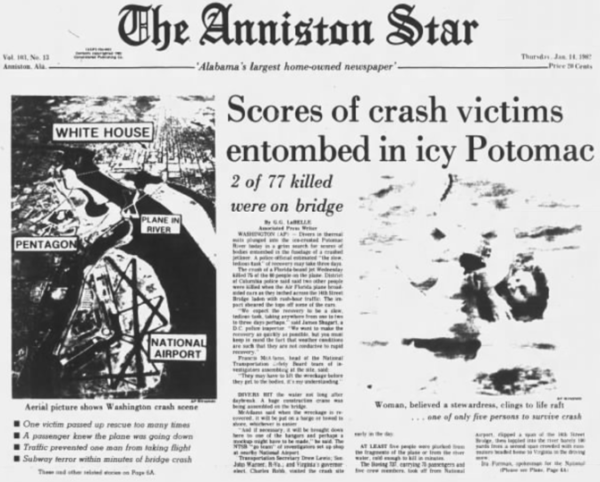January 13, 1982: Alabama Winter Storm and D.C. Plane Crash
A powerful cold front moved through on Saturday, January 9, 1982, sending temperatures plummeting. The high on Saturday was 49F, but it was down to 27F by midnight and the mercury was in a free fall like I had never seen. It was bitterly cold all day on Sunday, with the mercury slowly inching through the teens along with a powerful north wind and a few snow flurries. But even more interesting things were on the way. The NOAA Weather Radio that morning gave the standard two-day forecast with a three-day extended outlook. It called for rain or snow Tuesday night. That is all that a snow fan needed to hear, and with temperatures expected to drop to near zero, the prospects of some wintry precipitation had to be promising.
The morning low on Monday was 2F. The 500 mb chart told the story. A huge vortex was over Quebec, and a cross polar flow was delivering cold air straight into the Southeast. The mercury struggled back up to 27F on Monday, but with the high close by Monday night, winds went dead calm and the mercury plunged to –1F at the Airport during the evening hours. But in response to developing low pressure in the Gulf, cloud cover increased, and by midnight, it was back up to a balmy 13F.
Morning forecasts on Tuesday, January 12th had called for a winter storm watch for occasional sleet and freezing rain that would arrive by sundown. By mid-morning, as freezing rain and sleet across South Alabama were spreading rapidly north, the watch was changed to a winter storm warning. The snow arrived about 8 hours earlier than anticipated in the Birmingham area and quickly changed over to a mix of freezing rain and sleet that turned roads in skating rinks. Thousands of motorists had to abandon their vehicles on roads and hike home or spend the night in shelters. One suburban shopping mall became a huge shelter. So many wrecks occurred that the Birmingham Police Department could not answer the calls for accident investigation.
As temperatures hovered near the freezing mark through the night, freezing rain created a thick coating on all exposed objects. Trees snapped, pulling down power lines and putting as many as 750,000 Alabamians in the dark.
Travel became possible for a short while on Wednesday the 13th, as temperatures rose to just above freezing at lunch. But the sound of tree limbs snapping under the weight of the ice was like shotguns.
But the storm that was affecting the Southeast was pulling into the Northeast as well that Wednesday. Schools, businesses and even Congress shut down early. By early afternoon, highways and subway systems were under intense pressure as an exodus was underway. National Airport was closed for most of the morning. But reopened at mid-afternoon.
Air Florida flight 90, a 737 to Fort Lauderdale with 79 people aboard, was de-iced and ready to push back from the gate about 3:23 p.m. with temperatures in the 20s and over two feet of snow on the ground. The pilots decided to use the planes reverse thruster to back away from the gate. This would prove to be a serious mistake, as snow was sucked into the engines.
Palm 90 was number 16 for departure, and the pilots decided to let the hot exhaust from the planes in front of it on the taxiway melt the snow on the 737’s wings. It only pushed the snow to the trailing edge of the wings, where it refroze. Cockpit voice recorder tapes revealed that the crew neglected to turn the aircraft’s anti-icing system on despite the snow falling. The plane was cleared for takeoff, and as it rolled down Runway 36, First Officer Roger Pettit attempted to inform Captain Larry Wheaton that something was wrong, but was ignored.
The build-up of ice on the wings was causing the 737 to pitch upwards immediately after rotation. The plane was in a stall, no longer climbing, but falling towards the ground as the crew struggled in vain to gain altitude. The plane came down directly on top of the 14th Street bridge over the Potomac River where traffic was at a standstill due to the storm. Four automobiles on the bridge were crushed, killing 5 people on the ground. The aircraft crashed into the frozen river and sank in the icy waters.
Only 5 people on the plane would survive. The official cause of the crash was pilot error. When the pilots failed to activate the anti-icing systems, the snow in the engines caused compression instruments to read incorrectly, making the pilots think they had more power than they actually. The reduced power (about 70%) and ice covered wings caused the crash.
About one-half hour after the crash, a Metro subway train derailed because of a misaligned switch and crashed into a concrete abutment. Needless to say, the Washington transportation system was nearly paralyzed with National Airport and the 12 lanes leading from the city to Virginia closed along with the Blue and Orange lines of the Metro shut down.
Back here in Alabama, as we watched evening news reports about the crash and the storm, an upper-level disturbance was approaching. It would bring a nice snowfall that Wednesday night that led to some great sledding and snowball fights on Thursday. Snow fell as far south as the Florida Panhandle and the cold would wreak havoc on Florida’s citrus industry.
But when it was all said and done, twenty Alabamians were dead and another 300 injured and damage totaled $78 million. In D.C., 74 people died on the plane along with another five on the bridge. Three more died in the Metro accident.
Category: ALL POSTS, Met 101/Weather History


















